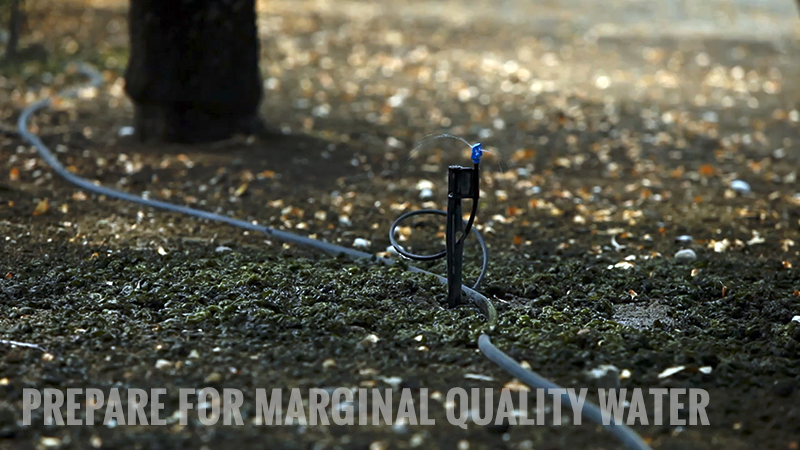Getting to the Root of Devastating Stone Fruit Fungus
Growers and researchers alike have become adept at navigating the tough environment of modern fruit growing — diseases, pests, storage disorders all can throw a monkey wrench into whatever plan there might be for a specific orchard. Most of the time, there’s a solution for whatever challenge it might be.
But, what if there was no such bright spot? Such is the case with Armillaria root rot, a deadly fungus that affects stone fruit (including almonds). The fungus enters the tree’s roots and plugs up the vascular system.
“Not only will infected trees collapse, typically right when they are nearing their maximum production capacity, but the orchard land is also rendered unsuitable for further peach or cherry production, thereby forcing prime orchard land out of production,” says Ksenija Gasic, Associate Professor of Horticulture at Clemson University.
“Not only will infected trees collapse, typically right when they are nearing their maximum production capacity, but the orchard land is also rendered unsuitable for further peach or cherry production, thereby forcing prime orchard land out of production,” says Ksenija Gasic, Associate Professor of Horticulture at Clemson University.
The Challenge With Longevity
Armillaria root rot lives in the soil in dead roots. It’s easily diagnosed by prominent white mycelial fans underneath the bark by the roots of the tree. Interestingly enough, Prunus varieties and the Armillaria fungus — also known as oak root rot — have a lot in common.
“It also prefers sandy soil, and so do Prunus trees,” says Amy Iezzoni, a Professor of Horticulture at Michigan State University.
The fungus’ longevity and ability to be spread from root-to-root contact gives growers few options. Often there are several infection sites in one orchard, researchers say.
“It’s notorious for being one of the longest-lived pathogens ever,” Iezzoni says. “Studies have determined that the fungus can spread root to root from about 7/10 of a foot to about 3 feet a year. It can also be spread via orchard equipment.”
Problem For Replant Sites
Land availability is a luxury that most growers don’t have, so replant sites are a necessary part of stone fruit production. However, Armillaria’s ability to survive and accumulate in the soil makes that difficult.
“If you have a tree that has died with Armillaria, there’s no point putting a replant in the now vacant spot because it’ll just die,” Iezzoni says.
And it goes without saying that with this longevity in the soil, so goes production and profitability. In fact, the fungus strikes hardest when trees are reaching the maximum production capability.
“Replant sites with a history of Armillaria root rot are considered economically unsuitable for continued peach and cherry cultivation,” Gasic says. “At such locations, it is not uncommon for trees of only three and four years of age to succumb to Armillaria root rot.”
A grower’s only recourse is to remove the infected trees and avoid replanting on that site. But, that’s in an ideal world.
“However, many growers are forced to reuse infested sites because new land may be unobtainable, unaffordable, or unsuitable for peach or cherry production,” Gasic says.
Limited Options
Growers have little they can do. Pre-plant fumigation, Gasic says can reduce inoculum by up to 60%.
“These do not eradicate the disease from the soil and only extend orchard life by just a few years,” she says.
Currently many peach growers are using above-ground root collar excavation, which was developed by fellow Clemson researcher, Guido Schnabel.
“While above-ground root collar will significantly delay tree mortality and increase orchard productivity, trees eventually will die from the disease,” Gasic says. “Trees will still succumb to the Armillaria root rot disease given enough time. Therefore, the most economical and potentially effective solution to combat Armillaria is the use of resistant rootstocks.”
Breeding For Resistance
This is where RosBREED 2 comes in. Gasic and Iezzoni are members of a larger team of researchers who are looking at finding sources of resistance to Armillaria root rot. However getting to the root of the problem means literally starting from the ground up, with RosBREED laying the foundation for research.
As is the case with fruit breeding, shortcuts to results just aren’t available.
“The biggest challenge we are facing is that there is no quick method to determine the susceptibility of new breeding lines to the disease,” Gasic says. “In-field assessments take years, and controlled environment attempts are also time consuming and difficult to conduct.”
Ray Hammerschmidt , a Professor at Michigan State University, has developed a bioassay to rapidly screen a number of rootstocks seedlings for their reaction to different Armillaria species. Both Gasic and Iezzoni say genetic material that is tolerant or resistant to Armillaria is also being used to help develop better early screening to detect promising material.
“What we’re trying to do is find sources of resistance in rootstock species that will keep trees alive long enough to make it economically viable to go back on that orchard site,” Iezzoni explains.
Gasic says Clemson colleague Greg Reighard is testing some new rootstocks to screen for Armillaria resistance. She also says a new USDA release, MP-29, is being tested by peach growers to see if tolerance or resistance is possible. Iezzoni says she has 200-300 cherry trees planted with a promising rootstock to test its susceptibility to the fungus.
Both Iezzoni and Gasic says that the urgency is both immediate and long term. In fact Clemson University was able to secure additional funding to further study solutions to the devastating fungus. Also, researchers in the peach, cherry, and almond industries are working together to share information so everyone in the stone fruit industry can benefit.
“The best scenario would be that we find resistant plant materials and growers can use these plant materials directly as rootstocks. In the meantime breeders can work on developing Armillaria resistant rootstocks that also include other desirable rootstock attributes,” Iezzoni says.










